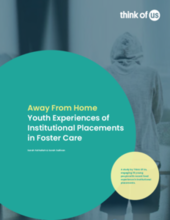Over the years, many reports, investigations, and assessments have shed light on the conditions that foster youth experience in institutional placements. For instance, a 2015 Department of Health and Human Services (HHS) report found that over 40% of children in institutions do not have a clinical reason for that acute of a setting (Children’s Bureau, 2015). A seminal study reported that residential treatment facilities lack oversight, and protective health and safety practices, and engage in substandard treatment, rights violations, and abuse (Behar et. al., 2007). Another study has shown how youth exposed to institutional care often suffer from “structural neglect” which may include minimum physical resources, unfavorable and unstable staffing patterns, and social-emotionally inadequate caregiver-child interactions” (Van IJzendoorn et al., 2011). Researchers have documented how institutions often fracture family relationships, rely on shift staff with often inadequate training and high turnover rates, expose youths to negative peer experiences (James, 2011), engage in restrictive placement policies, and mismatch placement decisions based on level of care needed (Lardner, 2015).
Despite this growing body of evidence, institutional placements persist. With little being done to overhaul the system, we believe that what is missing from the conversation is a deep, nuanced understanding of the lived experience and mental models of young people who have recently lived in institutional placements while in foster care, an understanding of institutional placements from youths’ perspectives. This study exists to fill that gap.

